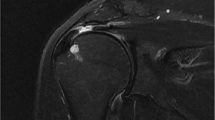Abstract
The transtendon suture-bridge technique is primarily indicated in concurrent articular- and bursal-side partial-thickness rotator cuff tears. The articular aspect of the footprint is restored using the transtendon technique while maintaining the remaining lateral footprint of the rotator cuff. The bursal aspect of the footprint is restored via the suture-bridge technique using the tied suture stands, after applying the transtendon technique while maintaining the remaining medial footprint of the rotator cuff. Using a combination of the transtendon and suture-bridge techniques, the articular and bursal aspects of the footprint are restored while maintaining the remaining footprint of the rotator cuff.



Similar content being viewed by others
References
Burkhart SS (2004) The principle of margin convergence in rotator cuff repair as a means of strain reduction at the tear margin. Ann Biomed Eng 3:166–170. doi:10.1023/B:ABME.0000007801.44277.df
Lo IK, Burkhart SS (2004) Transtendon arthroscopic repair of partial-thickness, articular surface tears of the rotator cuff. Arthroscopy 20(2):214–220. doi:10.1016/j.arthro.2003.11.042
Matava MJ, Purcell DB, Rudzki JR (2005) Partial-thickness rotator cuff tears. Am J Sports Med 33(9):1405–1417. doi:10.1177/0363546505280213
Park MC, Elattrache NS, Ahmad CS, Tibone JE (2006) “Transosseous equivalent” rotator cuff repair technique. Arthroscopy 22:1360
Trantalis JN, Boorman RS, Pletsch K, Lo IK (2008) Medial rotator cuff failure after arthroscopic double-row rotator cuff repair. Arthroscopy 24(6):727–731. doi:10.1016/j.arthro.2008.03.009
Weber SC (1997) Arthroscopic debridement and acromioplasty versus mini-open repair in the management of significant partial-thickness tears of the rotator cuff. Orthop Clin North Am 28:79–82. doi:10.1016/S0030-5898(05)70266-2
Weber SC (1999) Arthroscopic debridement and acromioplasty versus mini-open repair in the treatment of significant partial-thickness rotator cuff tears. Arthroscopy 15:126–131. doi:10.1053/ar.1999.v15.0150121
Wolff AB, Magit DP, Miller SR, Wyman J, Sethi PM (2006) Arthroscopic fixation of bursal-sided rotator cuff tears. Arthroscopy 22:1247e1–1247e4
Yoo JC, Ahn JH, Lee SH, Kim JH (2007) Arthroscopic full-layer repair of bursal-side partial-thickness rotator cuff tears: a small window technique. Arthroscopy 23:903e1–903e4
Author information
Authors and Affiliations
Corresponding author
Rights and permissions
About this article
Cite this article
Kim, K.C., Rhee, K.J., Shin, H.D. et al. Arthroscopic transtendon suture-bridge technique for concurrent articular- and bursal-side partial-thickness rotator cuff tears. Knee Surg Sports Traumatol Arthrosc 17, 1485–1488 (2009). https://doi.org/10.1007/s00167-009-0827-8
Received:
Accepted:
Published:
Issue Date:
DOI: https://doi.org/10.1007/s00167-009-0827-8




